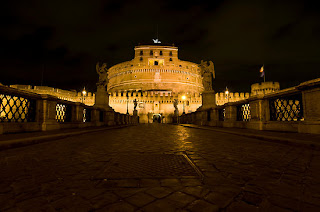Rome By Night
The old saying "When in Rome do as the Roman's do" is good advice. Rome is such a lovely place to stroll and the Romans are out in numbers to enjoy the summer nights.
One place to experience this local nightlife is at Piazza del Popolo, once Rome's northern gate. Every night crowds of Italians stroll and shop, with their teenagers working hard to be cool as they wander about the piazza.
The obvious destination from there is Piazza di Spagna, which is full of people day and night with its piazza and its famous steps - which attracted Goethe, Joyce, Byron, Shelley and Keats. Piazza di Spagna is largely its own enclosed universe, which feels even more insular at night, with a vertical exit signaled by the illuminated Fountain of the Barcaccia, a fanciful fishy barge, up the Spanish Steps to a glowing obelisk in front of the double towers of the church of the Trinità dei Monti.
For a more literal sense of the Roman night as theater, go south to the Trevi Fountain. This is one place that cannot be missed as art, spectacle and cultural icon. In front of your eyes Oceanus stands gleaming mightily as he tames the waters, a metaphor for the great feat of the aqueducts that brought water to the city. But inside many minds, no doubt, runs the famous night scene in Fellini's "Dolce Vita" of Anita Ekberg and Marcello Mastroianni stepping into the fountain. A dip, though, even if you look as great as they did, will land you in trouble, no matter how hot it is.
There is much to do at night, with perhaps the most spectacular activity being the most costly.
For 250 euros (about $400 at $1.60 to the euro) you can visit the Vatican Museum in small groups led by personal guides after hours. Galleries packed to a slow shuffle by day are, at night, emptied like drawing rooms of dreams. The Sistine Chapel is shared by as few as a dozen others, and no one yells if you take a picture. It's the time to go because unlike the daytime tours, You'll have it all to yourself.
Somehow the world's most famous chapel plays its part in defining the contrasts of Rome that are sharpest at night: the ceiling is Creation, and so newborn light and hope; the Last Judgment on the wall, torment and death.
If the price for a private tour too steep - a free stroll around St. Peter's Square is altogether different on a summer night. By day, the piazza is hot and clogged with long lines for the free look at St. Peter's Basilica. By night, the cobblestones of Via della Conciliazione, stretching to Bernini's colonnade and Michelangelo's dome and the obelisk dragged to Rome by the emperor Caligula, are all quiet, empty, luminous.
You can even check if Pope Benedict XVI is awake by looking for lights from his bedroom in the two top right windows facing the square in the Apostolic Palace, and contemplate what a shame it is that the Vatican has abandoned its most dramatic nighttime spectacle: for years on Easter, the complex was lighted with thousands of small paper lanterns, to apparently spectacular effect.
The setting may not be as showy, but a nighttime visit to the Janiculum Hill is no less magical. It is the most spectacular view of Rome - an organic and unimaginably wide panorama from the bright marble of the Vittoriano monument at Piazza Venezia to the dome of the Pantheon to the big bronze angel watching over Castel Sant'Angelo.
Though many restaurants and shops close in the summer, especially in August, the city makes up for it by opening many famous sites for concerts, movies and the like. Among the best is Castel Sant'Angelo, the stout half-barrel near the Tiber, built as the Emperor Hadrian's tomb, then in the Middle Ages transformed into a castle conveniently close to St. Peter's (via a hidden passageway in the Vatican walls) when troubled popes needed refuge.
Castel Sant'Angelo normally closes in early evening, but in the summer, it is opened for concerts, readings and late-night dining. A temporary beach, with actual sand, is laid down next door. The view from the top including a terrace designed by Michelangelo, is stunning, with the Vatican's dome on one side, all of Rome's center on the other and the river below.
Carlino's Restaurant is the perfect place to socialize and dine on exceptionally prepared meals with professional service.
So relax, indulge yourself and let Carlino's make you the sumptuous Italian feast you've been craving.
Sincerely,
Carlo and Wali
Carlino's Restaurant
204 Jericho Turnpike
Mineola, NY 11501-1701
Phone: 516-747-6616









